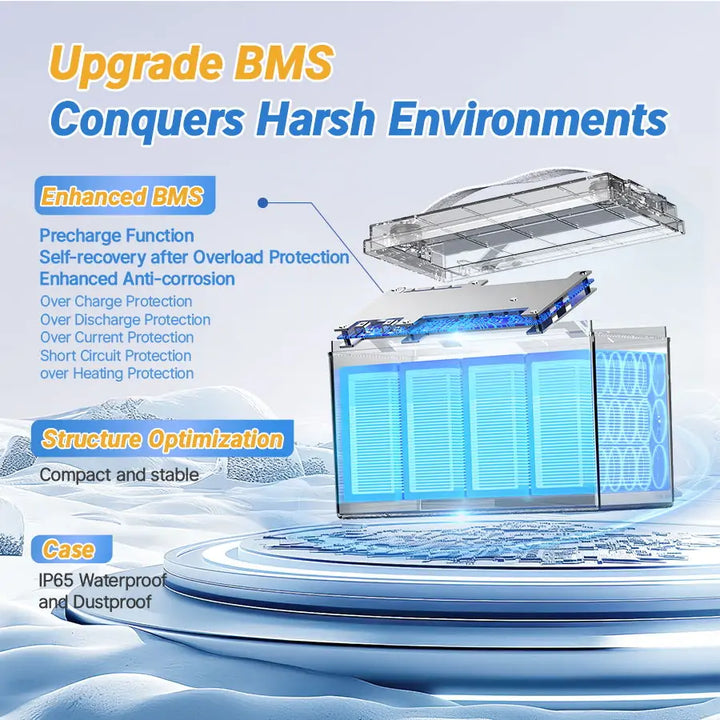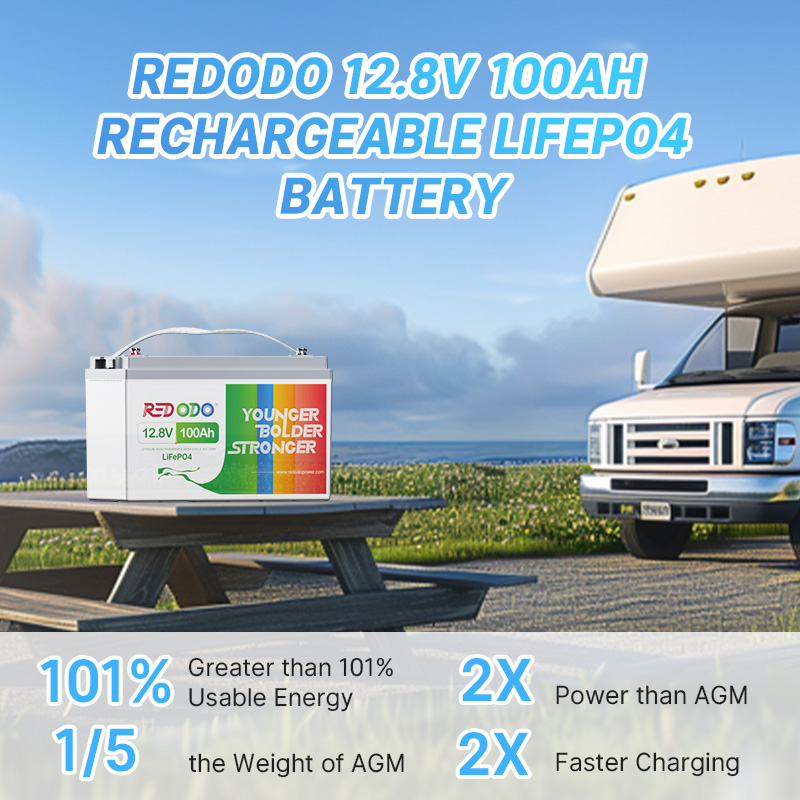To meet your power needs when you require more than one battery, there are two ways to set up your battery connection: a series connection or a parallel connection. Choosing the optimal configuration will depend on your power needs and the system requirements.
In this blog post, we'll explore the differences between series and parallel, the benefits and drawbacks of the two configurations, and which connection is better for your particular application.
Table of Content
Connecting Batteries in Series
Connecting batteries in series involves linking two or more batteries together in a chain, where the positive terminal of one battery connects to the negative terminal of the next. This method increases the overall voltage while keeping the capacity (Ah) the same.
For example, if you connect three 12V batteries in series, each with a capacity of 200Ah, you will get a total voltage of 36V (12V + 12V + 12V), but the capacity will remain at 200Ah.

Benefits of Batteries in Series
- Higher Voltage for High-Wattage Devices: Series connections allow you to easily increase the voltage to meet the demands of different devices.
- Potentially Longer Lifespan Due to Lower Current: The current is shared across all the batteries, reducing the load on each individual battery.
- Simplified Charging Process: Since the same current flows through all the batteries, charging is more uniform.
Drawbacks of Batteries in Series
- Increased Risk of Imbalance: If one battery degrades, it can create an imbalance in the system, as the performance of the entire series depends on the weakest battery.
- Requires a Battery Management System (BMS): A BMS is necessary to monitor and balance the batteries, but it adds to the cost of your setup.
Redodo LiFePO4 batteries come with an improved BMS that prevents overcharge, over-discharge, and short circuits. It also has an extra low-temperature cut-off protection for safety in extreme conditions.

Ideal Applications for Series Connections
Series connections are best suited for applications where higher voltage is essential:
- Electric Vehicles (EVs): EVs require high voltages to power their motors. Connecting batteries in series efficiently provides the needed voltage.
- Laptops and Smartphones: These devices use series connections to deliver efficient high voltages for extended usage.
- Power Tools: High-performance tools like drills and saws benefit from the high voltage provided by series-connected batteries.
- Solar Power Systems: Solar setups often use series connections for efficient power conversion from solar panels to electricity.
Connecting Batteries in Parallel
Connecting batteries in parallel involves linking all the positive terminals together and all the negative terminals together. This configuration increases the total capacity (Ah) while maintaining the same voltage.
For instance, if you connect two 12V batteries in parallel, each with a capacity of 100Ah, you’ll end up with a total capacity of 200Ah (100Ah + 100Ah) while the voltage remains at 12V.

Parallel connections are ideal when you need to maintain a constant voltage for extended periods. This setup allows your device to run longer because of the increased capacity. For boat owners, for example, more battery capacity means they can spend more time on the water.
Read More: How Long Do Marine Batteries Last & Tips To Maintain
Benefits of Batteries in Parallel
- Increased Capacity for Longer Runtime: Higher capacity means your devices can run longer without the need for frequent recharging or battery replacement.
- Better Tolerance for Battery Imbalances: In a parallel setup, a weaker battery won’t significantly impact the performance of the others.
- Easier to Maintain: Since perfectly matched batteries aren’t required, parallel configurations are simpler to maintain.
Drawbacks of Batteries in Parallel
- Higher Current Requires Thicker Cables: The increased current in parallel-connected batteries demands thicker cables to handle the load, preventing overheating.
- More Complex Charging Process: Charging can be challenging, as some batteries may overcharge while others undercharge. The same applies to discharging, where some batteries might deplete faster.
Ideal Applications for Parallel Connections
Parallel connections are ideal for applications that require increased power or capacity. For example:
- Electric Vehicle: Parallel connections can be used to combine the power output of multiple engines to drive heavy machinery or vehicles.
- Marine: It ensure continuous and reliable power supply for propulsion and onboard systems.
- Electrical Panels: Home wiring typically uses parallel configurations, ensuring that if one light or appliance goes out, the others remain powered.
Additionally, parallel connections are beneficial in data processing and networking, where multiple processors or communication channels can work together to handle large volumes of data more efficiently. Overall, parallel connections are well-suited for applications that demand higher performance, enhanced capacity, and improved redundancy.
The Factors to Choose the Right Configuration
Selecting the appropriate battery configuration—series or parallel—depends on several key factors:
- Power Requirements
Choose a series configuration for higher voltage needs and a parallel setup for higher current. For devices requiring both, consider a series-parallel configuration.
- Desired Runtime
Opt for a parallel setup if you need extended runtime, such as in solar power systems. For shorter runtimes, a series configuration will suffice.
- Battery Life
Series configurations maintain the same battery life but increase voltage, while parallel setups extend overall battery life, offering longer usage before recharge.
- Space and Weight
Series configurations save space by stacking batteries, whereas parallel setups need more space and increase weight, which is crucial if weight limitations exist.
- Safety Concerns
Parallel setups with higher currents can overheat, so thicker cables and proper insulation are essential. A Battery Management System (BMS) is recommended for both configurations to ensure safety.
- Maintenance
Parallel setups require less maintenance since a weak battery won't affect the system. Series configurations need careful monitoring, as a weak battery can compromise the entire system.
- Budget
Series setups are simpler and less expensive due to fewer wiring needs, making them ideal for budget-conscious projects. Though more costly upfront, parallel setups offer longer runtimes and require less maintenance.
Shop the best-budget 12V Lithium Battery and Group 24 Battery from Redodo today!
Which is Better: Series vs. Parallel Batteries
The decision to connect batteries in series or parallel depends on the specific requirements of your application. Here are some general guidelines to consider:
- Use Series Connection When:
- You need higher voltage for your application.
- Uniform current flow is important.
- You have limited space for additional batteries.
- Use Parallel Connection When:
- You need increased capacity without changing the voltage.
- Redundancy is important for your application.
- You have space for additional batteries.
In some cases, a combination of series and parallel connections may be used to achieve both higher voltage and increased capacity. This approach can provide a balance between voltage and capacity, making it suitable for a wide range of applications.
Can I Connect Batteries in Series and Parallel Simultaneously?
Yes, it is possible to connect batteries in both series and parallel configurations simultaneously, a setup known as a series-parallel connection. This is often done to meet specific voltage and capacity requirements.
For example, you can connect two 12V 100Ah batteries in series to achieve 24V, and then connect that series configuration in parallel with other two series of 12V 100Ah batteries. This would give you a system with 24V and 300Ah.

When wiring batteries in a series-parallel configuration, it is essential to follow these precautions:
- Use Identical Batteries: Ensure all batteries have the same capacity (Ah) and BMS (A).
- Same Brand: Use batteries from the same brand, as different lithium batteries from different brands may have unique BMS systems that are not compatible.
- Similar Purchase Time: Ideally, purchase the batteries within a short time frame (within one month) to avoid any imbalances.
FAQs on Series vs Parallel Connections
1. How Many Batteries Can You Wire in Series?
The number of batteries you can wire in series depends on the voltage limits of your system. For Redodo lithium batteries, it's recommended not to exceed 48V in a series setup.
Regularly balancing the charge across all batteries is crucial when using series connection. Additionally, use batteries of the same type, age, and capacity to avoid imbalances. Always ensure that you follow the manufacturer's recommendations and specifications when wiring batteries in series to avoid overloading or damaging the circuit.
2. How Many Batteries Can You Wire in Parallel?
The number of batteries you can wire in parallel is limited by factors like available space and the system's design requirements. However, balancing the charging and discharging cycles across all batteries is crucial for maximizing lifespan. Such as using thicker cables to handle the increased current and ensuring all batteries are of the same type, age, and capacity to avoid imbalances.
3. Do batteries last longer in series or parallel?
Typically, batteries last longer in parallel, because the voltage remains the same, but the amps increase. If you connect two 12V 100Ah batteries in parallel, it will still be a 12 volt system, but the amps will double to 200Ah, which is equal to a 12V 200Ah battery, so the batteries will last longer. On the other hand, if you connect batteries in series, voltage would be increased while capacity stays the same.
Conclusion
Understanding the differences between series and parallel battery connections is essential for optimizing your battery system. Series connections are ideal for increasing voltage, while parallel connections are better suited for increasing capacity. Your choice should be guided by the specific requirements of your application, including voltage needs, desired capacity, and the importance of redundancy.
If you have any questions or need help designing the perfect battery system, feel free to contact us and we’d love to provide any assistance for you. Don’t forget to subscribe to our newsletter to receive exclusive offers and the latest updates!
Suggested Reading: LiFePO4 Lithium Batteries in Series VS Parallel Connection

Redodo

Redodo
Recent Post

How Long Does a Trolling Motor Battery Last?

Convert RV from Lead-Acid to Lithium Battery: A Complete Guide

How Long Will a 200Ah Battery Run an Air Conditioner?

A Full Review of Redodo 12V 140Ah Group 31 Deep Cycle Battery



![⚡[$220 after Sign-Up] Redodo 12V 100Ah LiFePO4 Lithium Battery | Best Budget | For RV, Solar, Trolling Motor](http://www.redodopower.com/cdn/shop/files/Redodo_12v_100ah_lithium_battery_b9015ddd-64b5-4be2-8c88-392f0bb4ab30.jpg?v=1742973160)
![⚡[$220 after Sign-Up] Redodo 12V 100Ah Group 24 Deep Cycle LiFePO4 Lithium Battery | For Home, RV, Marine](http://www.redodopower.com/cdn/shop/files/Redodo_12V_100Ah_group_24_lithium_battery_6301965d-f6e8-467f-825f-3eec839b3e1f.jpg?v=1744105344)
![⚡[$239 after Sign-Up] Redodo 12V 100Ah Group 24 Bluetooth LiFePO4 Battery | Real-Time Battery Monitoring | For RV, Marine, Solar](http://www.redodopower.com/cdn/shop/files/Redodo_12V_100Ah_group_24_bluetooth_lithium_battery.jpg?v=1744253032)
![⚡[$220 after Sign-Up] Redodo 12V 100Ah Group 31 Bluetooth Lithium Battery | Real-Time Battery Monitoring | For RV, Marine, Solar](http://www.redodopower.com/cdn/shop/files/redodo_12v_100ah_bluetooth.webp?v=1744698930)
![⚡[$220 after Sign-Up] Redodo 12V 100Ah Mini Lithium LiFePO4 Battery | Smallest Battery | For RV, Trolling Motor, Solar](http://www.redodopower.com/cdn/shop/files/Redodo12V100AhMiniLiFePO4LithiumBattery.jpg?v=1739959054)
![⚡[$294 after Sign-Up] Redodo 12V 140Ah Group 31 Lithium Battery with Bluetooth | 40% More Capacity | For RV, Marine, Solar Home](http://www.redodopower.com/cdn/shop/files/Redodo_12V_140ah_bluetooth_battery_ee6d5fd1-5c7d-4b9a-90ab-d54d06b29a04.jpg?v=1742967763)
![⚡[$377 after Sign-Up] Redodo 12V 200Ah Lithium LiFePO4 Battery | 1280W Load Power | For RV, Solar, Off-Grid](http://www.redodopower.com/cdn/shop/files/Redodo12V200ahlithiumbattery.jpg?v=1735892910)

![⚡[$524 after Sign-Up] Redodo 12V 300Ah Lithium LiFePO4 Battery | Replaces 6*12V 100Ah AGM Batteries | RV, Marine, Solar](http://www.redodopower.com/cdn/shop/files/Redodo_12V_300ah_lithium_deep_cycle_battery.png?v=1744797523)
![⚡[$947 after Sign-Up]Redodo 24V 200Ah LiFePO4 Lithium Battery | Marine, Solar Home, Home Back up](http://www.redodopower.com/cdn/shop/products/24v200ahlithiumbattery-1.jpg?v=1735893113)